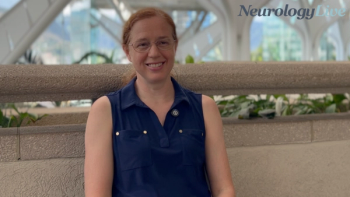
2023 MOGAD Criteria Yields High Accuracy of MOGAD Diagnosis in Real-World Study
The study found a 98% agreement between treating physicians’ initial diagnoses and the new MOGAD criteria.
A recently published real-world study assessing the applicability of the 2023 international myelin oligodendrocyte glycoprotein antibody-associated disease (MOGAD) panel criteria showed a strong concordance between the new criteria and treating physicians’ diagnoses. Investigators concluded that it is important to incorporate treatment response into the diagnostic criteria, as it has the potential to enhance accuracy and assist in differentiating MOGAD from other demyelinating disorders.1
In January 2023, a group of pediatric and adult neurologists, neuroimmunologists, and researchers convened to
Led by Adi Vaknin-Dembinsky, MD, PhD, a neurologist at Hadassah BrainLabs, the newly published, single-center study included 88 patients with MOG-IgG antibodies positive or borderline as described in the criteria, using cell-based indirect immunofluorescence assays. Most samples were taken before the initiation of therapy. Cases were divided to MOGAD and non-MOGAD patients according to treat neuroimmunologist prior to applying the new MOGAD criteria.
Among those included, the mean age at onset was 26.44 (±14.23) years, while the mean Expanded Disability Status Scale (EDSS) at onset was 1.7 (±1.73). When comparing the newly established criteria with the initial diagnoses made by treating physicians, it was found that 86 out of 88 (98%) patients maintained diagnoses. Only 2 patients initially diagnosed with MOGAD by their physicians did not receive the same diagnosis according to the new criteria. The overall agreement between the treating neuroimmunologists and the novel MOGAD criteria was considered exceptional, evidenced by a Cohen’s kappa value of 0.92.
"The findings from this study not only validate the new diagnostic criteria but also illuminate the diverse clinical spectrums within MOGAD and similar neurological disorders," Vaknin-Dembinsky et al wrote.1 "The study's results encourage ongoing research and refinement of diagnostic tools, ensuring they remain sensitive and specific to the evolving landscape of neurological disorders."
Within the patient cohort, 31 patients (25%) experienced a monophasic course, typical of MOGAD, while 37 (42%) exhibited a relapsing course, and 20 patients had not completed the 3-year surveillance necessary for course classification. On brain MRI, 47 patients (53%) demonstrated normal findings. In terms of clinical presentation, most patients first presented with optic neuritis (n = 49; 56%), with 9 experiencing bilateral optic neuritis (18%). Myelitis was observed in 22 patients (25%) and 8 patients (9%) presented with acute disseminated encephalomyelitis. The remaining patients presented with encephalitis (n = 2; 2%) or other (5%).
READ MORE:
When comparing differences between MOGAD and non-MOGAD patients, those with MOGAD showed significantly lower EDSS scores (1.429 [±1.574] vs 2.846 [±1.951]; P = .027), normal MRI scans at the time of disease onset (64% vs 25%; P = .02), preserved brain volume (46.196 [±37.271] vs 9.214 [±15.375]; P = .001), a negative result for oligoclonal bands (92% vs 31%; P <.0001), and a tendency toward more monophasic disease course (52% vs 17%; P = .006). In addition, those with a MOGAD diagnosis demonstrated specific types of relapses that differed from the non-MOGAD group, with occurrences of ADEM and encephalitis exclusively noted in the MOGAD cohort.
In a focused analysis of those who received a MOGAD diagnosis, investigators observed a trend toward earlier age of onset in monophasic patients (20.88 [±15.50] vs 28.00 [±13.64]; P = .07) with no significant differences observed in terms of EDSS (1.32 [±1.89] vs 1.23 [±1.15]; P = .84), percentage of female patients (48% vs 56%; P = .78) MRI brain abnormalities at onset (31% vs 41%; P = .63) or oligoclonal band positivity (9% vs 9%; P = 1.00). Although not statistically significant, patients with a monophasic course tended to experience more myelitis relapses (28% [8 of 29] vs 11% [3 of 27]), while relapsing patients more frequently had relapses involving both myelitis and optic neuritis (3% [1 of 29] vs 22% [6 of 27]).
Regarding the 2 patients who were initially diagnosed with MOGAD by their clinicians but did not receive MOGAD diagnosis by the criteria, investigators wrote, “In the first case, the observed deterioration following MS treatments and a clinical attack occurring during the tapering down of steroids, and in the second case, the positive response to IVIG, were crucial factors guiding physicians toward a MOGAD diagnosis not supported by the new criteria. Both patients had positive MOGAD antibodies also in the 1:100 dilution. In light of these instances, there is a compelling argument for considering the inclusion of treatment response in diagnostic criteria. Doing so could enhance accuracy and aid in distinguishing MOGAD from other demyelinating disorders."1
REFERENCES
1. Rechtman A, Freidman-Korn T, Zveik O, et al. Assessing the applicability of the 2023 International MOGAD panel criteria in real-world clinical settings. Journal of Neurol. 2024;271:5102-5108. doi:10.1007/S00415-024-12438-6
2. Banwell B, Bennett JL, Marignier R, et al. Diagnosis of myelin oligodendrocyte glycoprotein antibody-associated disease: International MOGAD Panel proposed critieria. Lancet Neurol. Published online January 24, 2023. doi:10.1016/S1474-4422(22)00431-8.
Newsletter
Keep your finger on the pulse of neurology—subscribe to NeurologyLive for expert interviews, new data, and breakthrough treatment updates.








































